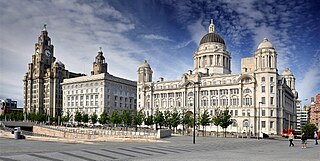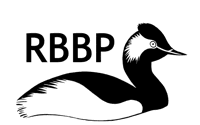Related Research Articles

RSPB Leighton Moss is a nature reserve in Lancashire, England, which has been in the care of the Royal Society for the Protection of Birds since 1964. It is situated near Silverdale, Carnforth, on the edge of Morecambe Bay and in the Arnside and Silverdale Area of Outstanding Natural Beauty.

Merseyside is a ceremonial and metropolitan county in North West England. It borders Lancashire to the north, Greater Manchester to the east, Cheshire to the south, the Welsh county of Flintshire across the Dee Estuary to the southwest, and the Irish Sea to the west. The largest settlement is the city of Liverpool.

The River Mersey is a major river in North West England. Its name derives from Old English and means "boundary river", possibly referring to its having been a border between the ancient kingdoms of Mercia and Northumbria. For centuries it has formed part of the boundary between the historic counties of Lancashire and Cheshire.
Christopher John Mead was a popular British ornithologist, author and broadcaster, and an influential member of the British Trust for Ornithology (BTO).

The British Trust for Ornithology (BTO) is an organisation founded in 1932 for the study of birds in the British Isles. The Prince of Wales has been patron since October 2020.
Colin Joseph Bibby was a British ornithologist and conservationist.

The Hilbre Islands are an archipelago consisting of three islands at the mouth of the estuary of the River Dee, the border between England and Wales at this point. The islands are administratively part of the Metropolitan Borough of Wirral. They are a Local Nature Reserve and are within the estuary Site of Special Scientific Interest. As of 2012, the islands have no permanent residents. The name is thought to derive from a chapel built on the Island and dedicated to St. Hildeburgh. Visitors typically travel by foot to the Islands from West Kirby.

Gibraltar Point national nature reserve is an area of about 4.3 km2 (1.7 sq mi) on the coast of Lincolnshire, England.

The Wirral Peninsula, known locally as the Wirral, is a peninsula in North West England. The roughly rectangular peninsula is about 15 miles (24 km) long and 7 miles (11 km) wide, and is bounded by the Dee Estuary to the west, the Mersey Estuary to the east, and Liverpool Bay to the north.

Otmoor RSPB Reserve is a nature reserve, managed by the RSPB, between Beckley and Oddington, within the wider area of Otmoor, in Oxfordshire, England. The reserve was established in 1997 and restored large areas of marshland from what had previously been farmland. The RSPB reserve covers around 1,000 acres (400 ha).

The Dee Estuary is a large estuary by means of which the River Dee flows into Liverpool Bay. The estuary starts near Shotton after a five-mile (8 km) 'canalised' section and the river soon swells to be several miles wide forming the boundary between the Wirral Peninsula in north-west England and Flintshire in north-east Wales. The Dee Estuary's largest towns along it include Holywell, Flint, Connah's Quay, Shotton, Queensferry, Saltney Ferry, Heswall, West Kirby and Neston as well as other villages and towns alongside it. The A548 also passes along the estuary in Wales and parts of Cheshire West and Chester and Merseyside in England. The North Wales Coast Line follows the course of the Dee Estuary between Prestatyn and Chester.

Burton Mere Wetlands is a nature reserve on the Dee Estuary straddling the border between Cheshire, England and Flintshire, Wales. It is run by the Royal Society for the Protection of Birds (RSPB) and incorporates the older Inner Marsh Farm reserve. It lies near the village of Burton, about 3 kilometres (1.9 mi) south of Neston. It has all been developed by the RSPB and includes a large area of mixed wetland habitats, bluebell woodlands, and arable fields all managed to attract wildlife.

Lodmoor is a Site of Special Scientific Interest (SSSI), RSPB reserve and country park in Dorset, England. The country park features a visitor centre, model railway and pitch and putt golf course. The SSSI has a wetland habitat with native birds that are rare in the UK and a range of migratory species.

Ynys-hir RSPB reserve is a nature reserve of the RSPB situated beside the Dyfi estuary in Ceredigion, mid Wales between Aberystwyth and Machynlleth. The reserve covers 550 hectares and includes a variety of habitats extending inland from mudflats and salt marsh through farmland and pools to oak woodland and hillside scrub. Facilities include a small visitor centre and seven hides.

Red Rocks (SSSI) is an area of sand dunes and reed beds at the mouth of the Dee Estuary and to the west of Hoylake on the Wirral Peninsula, England.

Conwy RSPB reserve is a nature reserve of the Royal Society for the Protection of Birds situated on the east side of the Conwy estuary in Conwy county borough, North Wales. It covers 47 hectares and protects a variety of habitats including grassland, scrubland, reedbeds, salt marsh and mudflats. It was created as compensation for the destruction of areas of wildlife habitat during the construction of the A55 road tunnel under the estuary between 1986 and 1991. Waste from dredging was dumped onto the site which was later landscaped to create two large pools and several smaller ones. The reserve opened to the public on 14 April 1995 and facilities for visitors now include a visitor centre, café and three hides. A farmers' market is held on the reserve car park each month.

The Rare Breeding Birds Panel (RBBP) is an ornithological body which collects data on the breeding attempts and successes of the rarer species of birds breeding in the United Kingdom. It was created in 1968 as a subcommittee of the RSPB, with representation from the Nature Conservancy Council (NCC) and British Birds magazine.

The Gower Ornithological Society is a society for professional and amateur birdwatchers covering the geographical areas of south Wales comprising Gower, Swansea, Neath and Port Talbot.

Blindwells is a new town under construction in East Lothian, Scotland.

Adur Estuary is a 62.2-hectare (154-acre) biological Site of Special Scientific Interest on the western outskirts of Shoreham-by-Sea in West Sussex. Part is a Royal Society for the Protection of Birds nature reserve.
References
- 1 2 3 4 5 6 7 "English Nature announce acting Chairman". English Nature. 28 September 2000. Archived from the original on 22 July 2007. Retrieved 26 November 2008.
- 1 2 3 4 5 "Current Panel Members". Rare Breeding Birds Panel. Archived from the original on 31 December 2016. Retrieved 27 November 2008.
- ↑ Holling, Mark; The Rare Breeding Birds Panel (June 2007). "Rare breeding birds in the United Kingdom in 2003 and 2004" (PDF). British Birds. 100 (6): 321–367. ISSN 0007-0335. Archived from the original (PDF) on 24 September 2015. Retrieved 29 August 2015.
- 1 2 3 "RSPB Council". RSPB. Archived from the original on 3 March 2008. Retrieved 26 November 2008.
- ↑ "Medallists". BTO. 2 June 2006. Retrieved 27 November 2008.